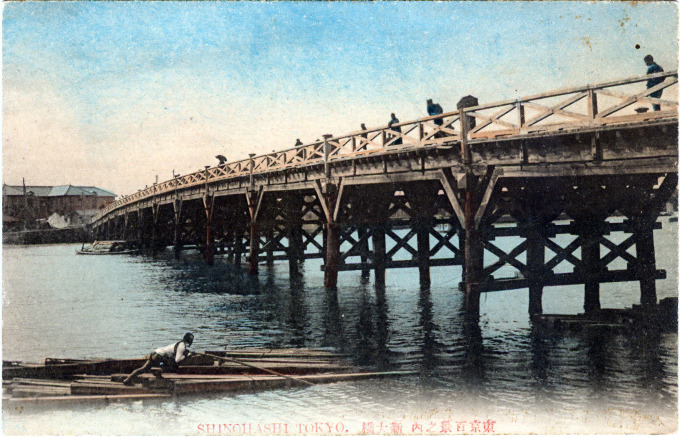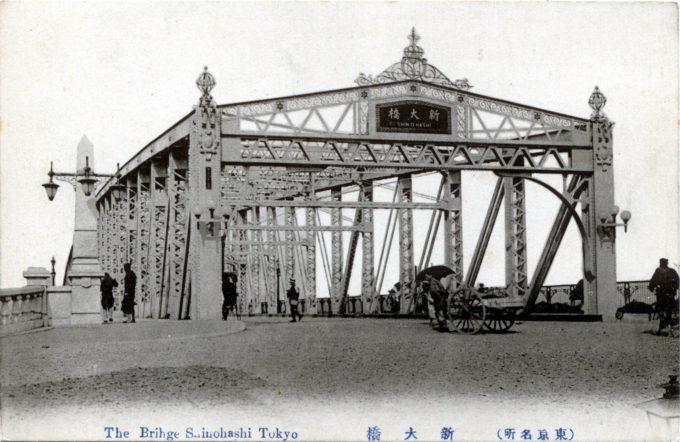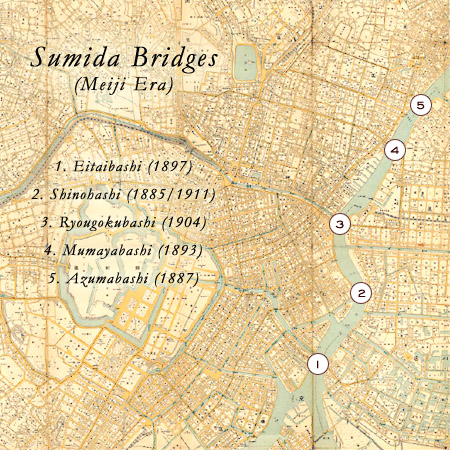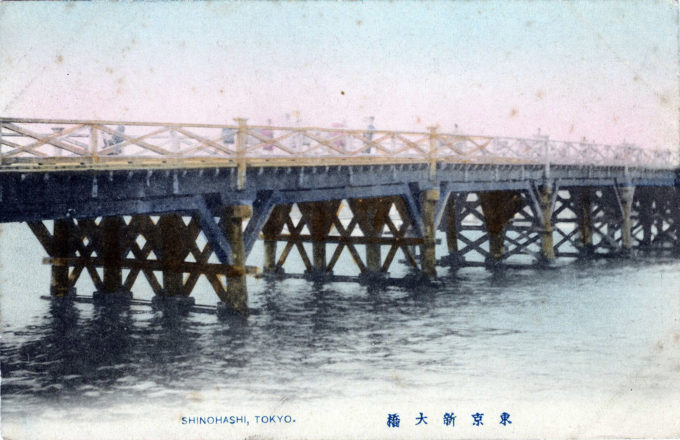
Shinohashi Bridge, as standing c. 1910 before its replacement. This wooden structure (above) was erected across the Sumida River in 1885, the last wooden bridge built across the Sumida during the Meiji era, and it stood there until replaced by a modern steel span in 1911.
See also:
Ferry Boat (Yakata-bune), Sumida River, c. 1911
“From the beginning of the Meiji era [Tokyo] was gradually rebuilt as the new capital of the Japanese Empire. The number of earth-walled houses dwindled daily, to be replaced by Western-style buildings. The rebuilding of the main roads of Nihonbashi was much talked about, and comments appeared in the newspapers like, ‘I think they’re making it all too Western. Surely the old Japanese-style earth-walled houses would give the capital more charm?’
“But the demands of the new city kept on growing. Onari Street grew bigger as you watched it, and the main roads became much wider. What with the reconstruction of the ridges and the removal of the firebreaks and the improvement of the narrow streets, a bit more of the Edo of old was destroyed with each passing day.
“… Of the five great metropolitan bridges it was Shinohashi that remained in its original wooden state the longest. How I miss those days when all five of them – Umayabashi, Azumabashi, Ryogokubashi, Shinohashi, and Eitaibashi – were old-style, Edo-style wooden bridges. When I think, as a further example, that there are said to be hardly any old-style covered boats left in Tokyo nowadays, I realize just how much the city has changed over the years.”
– “Remodelling the City”, by Tayama Katai, Thirty Years in Tokyo, 1917 (translated by Kenneth G. Henshall, 1987)
“In 1910, only five bridges spanned the Sumida River. Now (in 2014) there are 14.
“Shin-o-hashi [new great bridge] was first erected in 1673 downriver from the Ryogokubashi and rebuilt of wood numerous times — mostly recently in 1885 (the image above).
“In 1911, the wooden Shinohashi would be replaced by a modern iron truss span (below).
“Shinohashi was the last of the great wooden spans built during the feudal Tokugawa Era that crossed the waterway dividing Tokyo’s Low City [Shitamachi] of workers’ housing and shops from the High City, Yamate [mountain hand], of daimyo estates and Edo Castle.”
“Shin Ohashi, ‘New Great Bridge,’ built on the site of Hiroshige’s ‘Ohashi’ in 1911, was the last Meiji bridge erected to span the Sumida River, the strongest and the most technically advanced, using, like late Meiji buildings, Carnegie steel.
“It had the usual three-span Pratt trusses but unlike the others had a steel-plated roadway instead of a wooden deck. Decoratively, too, it outshone the others.
“To the basic bridge a pedimented portal topped with airy scrollwork and globes made of steel ribbons had been added. Electric scones projected from the portal posts. Curving granite balustrades illuminated by lights mounted on granite obelisks led to the walkways lining each side of the bridge. And the steel railings displayed the sinuous curves and circles of a new Western style just now entering Japan – Art Nouveau.
“… The splendid Shin Ohashi did not succumb to the [1923] quake and was not replaced until 1974 when it was moved to Meiji Village [Nagoya], which found space across a pond for one span, roughly one-eighth of its original 173 meters. ‘Carnegie’ can still be read on the members.”
– Meiji Revisited: The Sites of Victorial Japan, by Dallas Finn, 1995

“The Brihge [sic] Shionhashi.” The steel truss Shinohashi, completed in 1911, replaced the last wooden bridge to span the Sumida River.




Pingback: Ferry Boat, Sumida River, Tokyo, c. 1911 | Old Tokyo
Pingback: Azumabashi Bridge, Tokyo, c. 1910. | Old Tokyo
Pingback: Post-earthquake Bridge Construction, Tokyo, c. 1932. | Old Tokyo